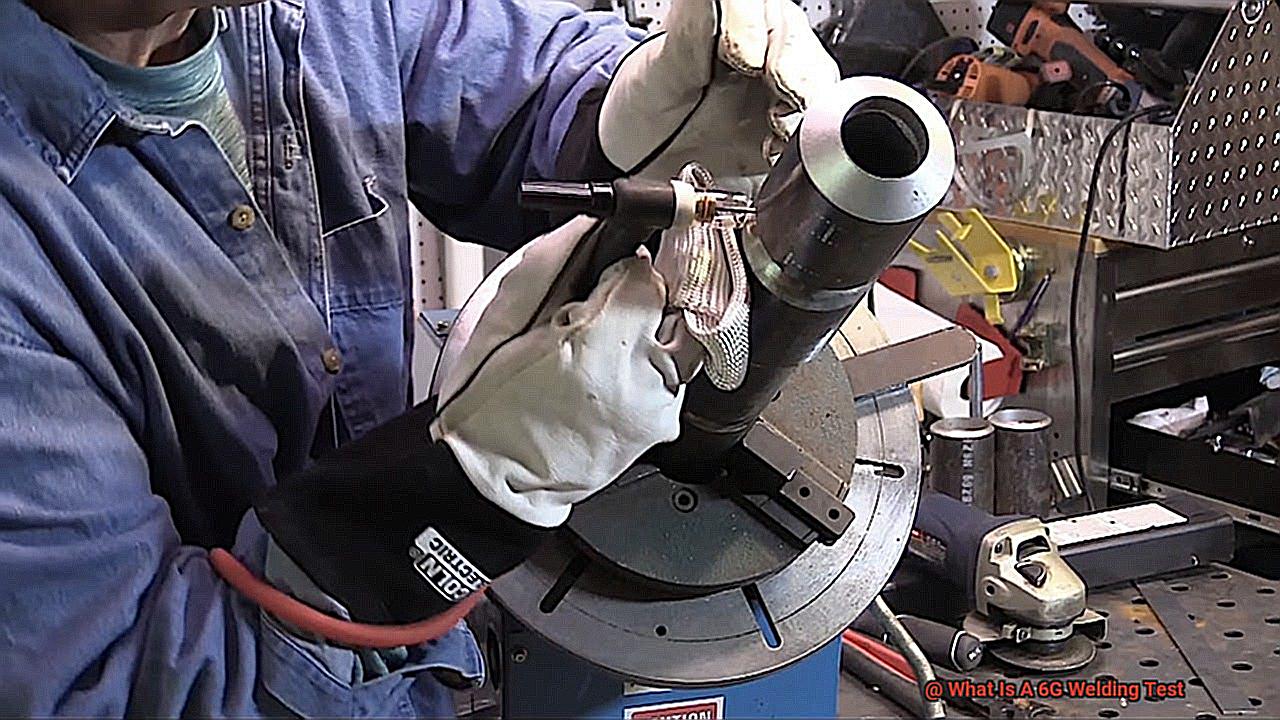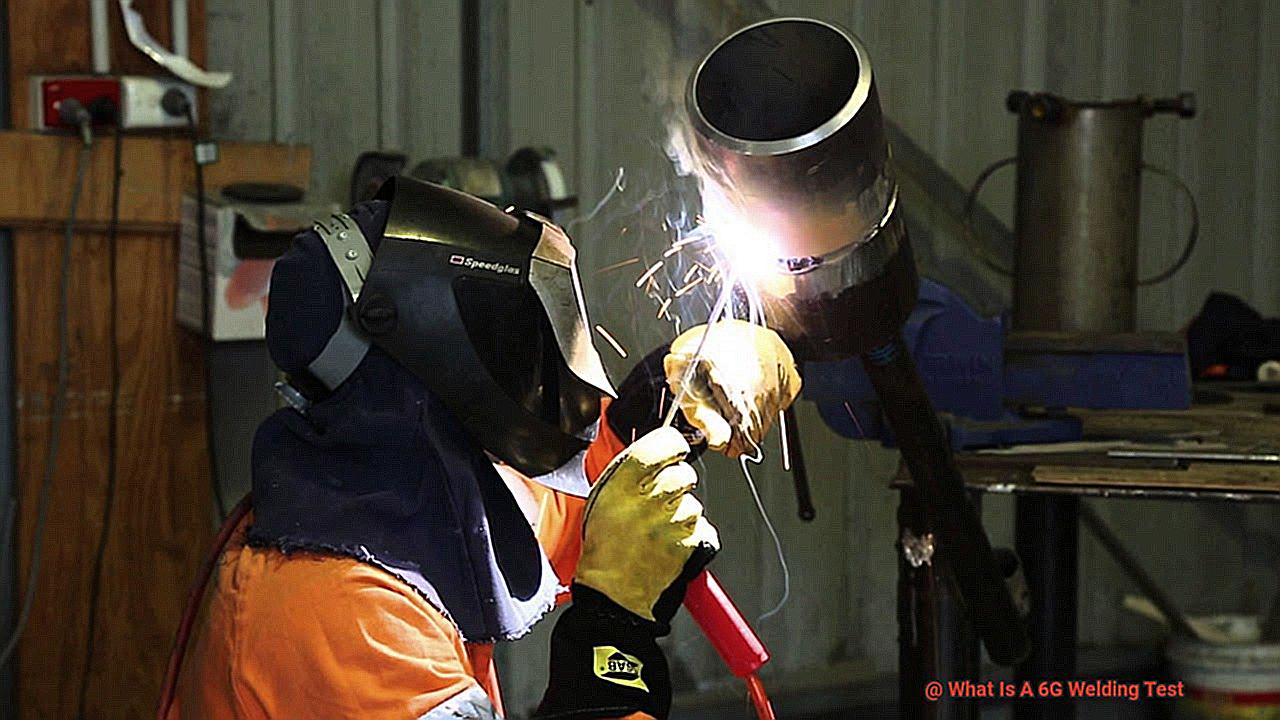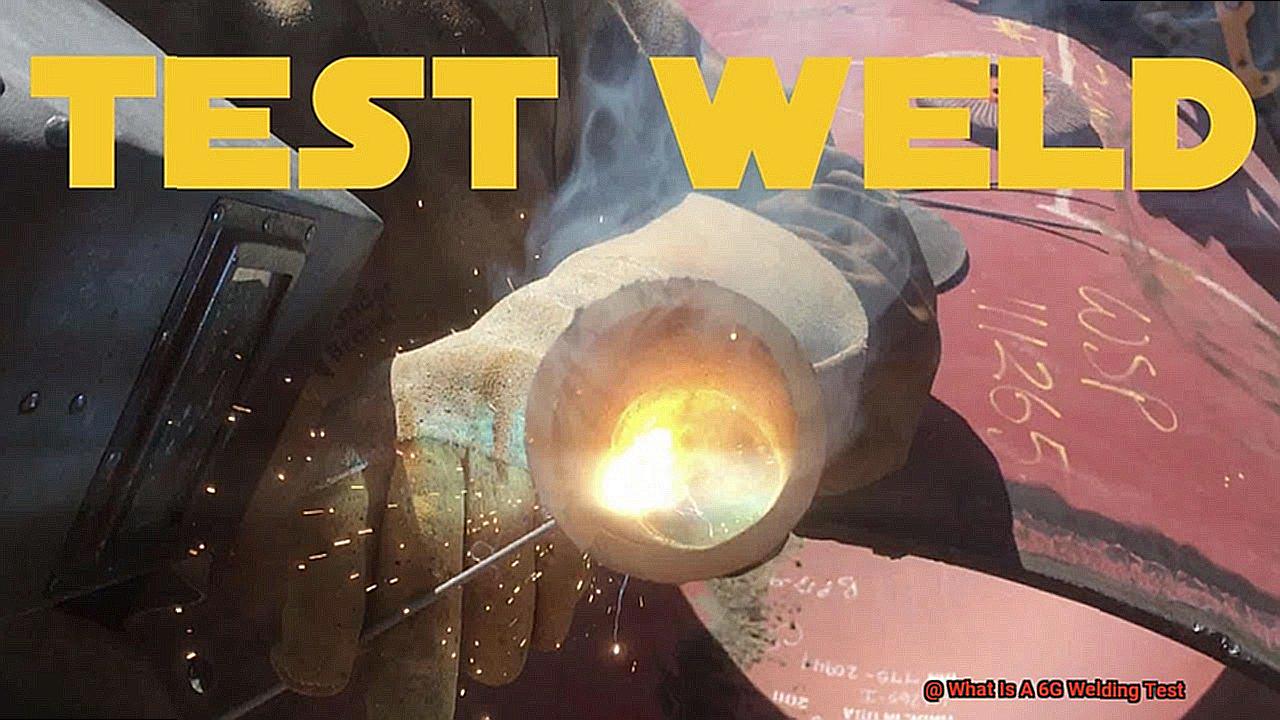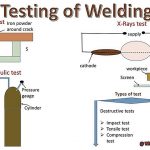Welcome to the world of welding, where precision and expertise are essential.
As technology continues to advance, the demand for skilled welders only grows. And with that demand comes the need for specialized welding tests, such as the 6G welding test.
Whether you’re a seasoned welder or just starting out in the field, you may have heard of this elusive test but aren’t quite sure what it entails. Fear not, my fellow welders.

So, put on your trusty welding helmet and let’s explore the world of 6G welding together.
What is 6G Welding Position
Contents
The 6G welding position is the ultimate challenge for welders. It is considered the most perplexing position in groove welding, requiring a high degree of proficiency, experience, and precision. In this position, the welder must work on a pipe that is inclined at a 45-degree angle and rotated while welding. This means that the welder must possess exceptional hand-eye coordination and produce consistent welds while working in an overhead position. Sounds like a daunting task, doesn’t it? Let’s delve deeper into the intricacies of this welding position.
What makes 6G welding so perplexing?
The 6G welding position goes beyond producing aesthetically pleasing welds. It demands a unique blend of technical expertise, physical prowess, and mental acuity. Here are some reasons why it is considered the ultimate test for welders:
- Welding in an inverted position: In the 6G position, the welder must work with their hands above their head, making it a physically demanding task. It necessitates superior hand-eye coordination, dexterity, and strength to hold and maneuver the welding torch for extended periods.
- Working on an inclined pipe: The pipe is inclined at a 45-degree angle, which means that the welder must be able to adapt their body positioning and maintain a consistent torch angle while welding. This can be baffling as it requires exceptional balance, stability, and control.
- Mastery of diverse welding techniques: To pass a 6G welding test, a welder must exhibit expertise in various welding techniques such as SMAW, GTAW, and FCAW. They must also be able to switch between these techniques seamlessly while maintaining quality and consistency.
- Adhering to strict protocols: The 6G welding test evaluates not just the appearance of the welds, but also a welder’s ability to adhere to specific protocols and techniques precisely.
Where Do You Use 6G Welding
The art of welding is not for the faint of heart. It requires a high level of expertise, agility, and precision, especially when it comes to the 6G position. This is considered the ultimate test of a welder’s skills, often referred to as the Mount Everest of welding challenges. But where exactly is this specialized welding process used?
The answer lies in a diverse range of industries, each with their own unique demands and requirements. Let’s take a closer look at how 6G welding plays a critical role in shipbuilding, oil and gas, construction, military applications, and fabrication.
Shipbuilding:
Building a ship that can withstand the harsh conditions of the ocean is no easy feat. It requires strong and durable welds, which is where 6G welding comes into play. This process is used to join steel plates together to create the hull of a ship. The welds must be able to withstand the pressure and force of the ocean, making 6G welding an essential skill in shipbuilding.
Oil and Gas:
The oil and gas industry also heavily relies on 6G welding for its pipelines, refineries, and offshore platforms. These welds must be able to withstand high pressure and extreme temperatures, ensuring the safety and functionality of these structures.
Construction:
From bridges to skyscrapers, construction projects require strong welds that can support heavy loads and endure harsh weather conditions. This is where 6G welding comes into play, ensuring the structural integrity of these impressive buildings.
Military Applications:
In military applications, strong and durable welds are crucial for weapons systems, vehicles, and equipment. 6G welding is used to ensure the reliability and safety of these critical tools used by our armed forces.
Fabrication:
The fabrication industry also relies on 6G welding for pressure vessels, boilers, and other heavy machinery. These welds must be able to withstand high pressure and stress, making 6G welding a crucial skill in this field.
Characteristics Of The 6G Welding Position
The 6G welding position – it’s like climbing the peak of Mount Everest, only with a welding torch as your tool of choice. To even attempt this formidable position, one must possess nerves of steel, masterful skills, and a meticulous eye for detail. But what sets the 6G welding position apart from others? Let’s take a closer look at its unique characteristics.
Fixed Angle:
Unlike other welding positions that involve rotating or moving the pipe, the 6G position requires the pipe to be fixed at a 45-degree angle. This fixed position presents a whole new set of challenges, as the welder must maneuver around the pipe to complete the weld.
Clear Visibility:
One of the advantages of the 6G position is its clear visibility of the weld joint and welding puddle. This allows for better control of the welding arc and results in high-quality welds. However, this also means that any mistakes or imperfections are easily visible, making precision and attention to detail crucial.
Certification and Expertise:
Due to its level of difficulty, 6G welding demands certified and highly experienced welders. The American Welding Society (AWS) offers a certification program specifically for 6G welders, ensuring that they have the necessary skills and experience to handle this challenging position.
High Demand:
With its critical role in industries such as shipbuilding, oil and gas, construction, and fabrication, there is a high demand for skilled 6G welders. This position offers excellent job opportunities for certified welders who can master this challenge.
Challenges and Opportunities:
While the 6G position may seem daunting to some, it also presents opportunities for growth and advancement in the welding industry. Mastering this position showcases a welder’s expertise and can lead to higher-paying jobs and increased job security.
In conclusion, the 6G welding position is not for the faint-hearted.
What is the Qualification Range for 6G
Achieving mastery in passing the 6G welding test is an arduous journey. It requires a high level of expertise, precision, and unwavering determination. But what exactly is considered the acceptable range for this rigorous assessment?
To fully comprehend the qualification range for the 6G welding test, it is essential to first understand the test itself. The “6G” designation specifies the position of the pipe being welded – at a 45-degree angle with its axis fixed in place. This position demands advanced skills in both vertical and horizontal welding techniques, making it one of the most challenging tests for welders.
However, it is not solely about the pipe’s position. The 6G welding test also entails welding on carbon steel pipes with a diameter of 2 inches or more. The length of the pipe may vary, but it typically falls between 18-24 inches. To successfully pass this test, a welder must complete three different types of welding passes – root pass, fill pass, and cap pass – without any flaws.
So what is considered an acceptable range for this demanding test? Primarily, it depends on the thickness of the pipe being welded. According to the American Welding Society (AWS), the minimum thickness for a pipe in a 6G position is 3/8 inch. However, some companies may require a thicker pipe to meet their specific welding needs. Conversely, the maximum thickness can fluctuate depending on the welding code in use, with AWS D1.1 code specifying a maximum thickness of 2 inches for a 6G pipe.
But thickness is not the only factor at play. Other elements such as welding process, position, and material type can also impact the qualification range for the 6G welding test. For example, pipes made of stainless steel or other alloys may have different requirements than those made of carbon steel.
It is worth noting that the qualification range may also vary based on industry or company standards.
Pros
If so, you’re embarking on a path towards a thriving and gratifying career. Possessing advanced skills and expertise in all positions, 6G welders are highly coveted in various industries. However, the benefits of this certification go beyond just job opportunities. Let’s delve into the advantages of becoming a certified 6G welder.
Endless Opportunities
Arguably the most significant perk of obtaining a 6G welding certification is the abundance of job opportunities it unlocks for you. Many industries, including construction, oil and gas, and manufacturing, place high value on this certification and are constantly seeking skilled 6G welders. This means you’ll have a plethora of job options to choose from, making it easier to find a role that aligns with your interests and aspirations.
Lucrative Wages

With advanced skills comes higher pay. 6G welders are in high demand and often receive better compensation compared to other welders. This is due to the level of expertise and precision required for this certification. Employers are willing to pay top dollar for proficient 6G welders who can adeptly handle complex welding tasks.
Versatility in Welding Tasks
As a certified 6G welder, you’ll possess the versatility to tackle a wide range of welding tasks with ease. This is because the 6G position entails welding at a 45-degree angle on carbon steel pipes of varying lengths and diameters, making it one of the most adaptable welding positions. With this certification, you’ll be equipped to take on diverse projects and challenges, making your job more dynamic and stimulating.
Stronger Welds in Less Time
The 6G welding process produces robust and efficient welds that are less prone to cracking or breaking. This is attributed to the advanced techniques utilized in this position, such as weaving and stringer beads.
Cons
Although this credential can open up numerous career prospects and higher income potential, it comes with its fair share of obstacles and constraints that one must be cognizant of before taking the plunge.
Physical Exertion:
The 6G welding test presents a significant physical challenge for welders. The position requires intricate hand and arm movements in uncomfortable positions, leading to fatigue and discomfort. This can prove to be especially daunting for welders with prior injuries or physical limitations.
Investment of Time and Resources:
Achieving certification as a 6G welder demands a considerable investment of both time and money. Welders must undergo extensive training and practice before attempting the 6G test, which can span weeks or even months. Additionally, the expenses associated with materials and testing fees can be exorbitant, rendering it an unattainable goal for aspiring welders on a tight budget.
Restricted Scope:
While passing the 6G test is undoubtedly an impressive feat, it only certifies welders for one specific position. This can severely limit job opportunities as many employers require their welders to possess proficiency in multiple positions, including overhead, horizontal, and vertical.
Detachment from Real-World Scenarios:
Despite its challenges, the 6G welding test may not necessarily be an accurate reflection of a welder’s performance in real-world scenarios. The controlled conditions and limited scope of the test do not always mirror the complexities and variables that welders encounter on the job. This can result in a false sense of confidence among some welders and potential issues when they begin working on actual projects.
In conclusion, while obtaining certification as a 6G welder can yield numerous advantages, it is crucial to acknowledge the potential drawbacks and limitations of this credential. Welders must not solely depend on this certification as the sole measure of their abilities and expertise.
5G vs 6G Welding Positions
Welding is a craft that demands precision, patience, and mastery. As a skilled welder, you are no stranger to the diverse welding positions used in various industries. But for those new to this world or seeking to expand their knowledge, the disparities between 5G and 6G welding positions may be perplexing.
In this piece, we will delve into the intricacies of these two crucial welding positions and explore their varying levels of complexity, necessary skills, and equipment. By the end, you will have a comprehensive understanding of 5G vs 6G welding positions and their significant role in welding.
The Conundrum: Unraveling 5G vs 6G Welding Positions
At the heart of the dissimilarities between 5G and 6G welding positions lies their level of complexity and difficulty. Let us dissect it.
5G Welding Position:
Also known as the flat position, 5G involves performing welding on a horizontal surface while maintaining a horizontal angle. This position is relatively simple compared to others and is often used for fillet welds or lap joints.
6G Welding Position:
In contrast, 6G is a more demanding position where the welder must perform welding on a pipe joint fixed at a 45-degree angle while continuously rotating it. This perpetual rotation makes it arduous to maintain a consistent arc length and produce uniform, high-quality welds.
The Skill Set and Expertise Factor
Both 5G and 6G welding positions require advanced skills, but there is a notable disparity in the level of expertise needed.
5G Welding Position:
The 5G position is comparatively easier, making it ideal for beginners or those with limited experience in welding. However, it still demands a certain level of mastery and precision to produce top-notch welds.
Conclusion
In summary, the welding industry is constantly evolving and the demand for skilled welders is on the rise. One of the most challenging tests in this field is the 6G welding test, which requires a high level of proficiency and precision.
The 6G welding position involves working on a pipe at a 45-degree angle while rotating it, making it a difficult task that demands exceptional hand-eye coordination and mastery of various welding techniques. This position is utilized in industries such as shipbuilding, oil and gas, construction, military applications, and fabrication, providing numerous opportunities for certified 6G welders with advanced skills.
While obtaining certification as a 6G welder may come with challenges such as physical exertion and investment of time and resources, the benefits far outweigh them. Certified 6G welders have access to higher-paying jobs with versatile tasks and can produce stronger welds in less time.
It’s important to note that there are differences between the 5G and 6G welding positions in terms of complexity and required skill set. While both positions require advanced skills, mastering the 6G position showcases a higher level of expertise.
In conclusion, conquering the 6G welding position can be compared to climbing Mount Everest with a welding torch as your tool. It may seem daunting at first, but with determination and practice, it can lead to a rewarding career in the world of welding.





